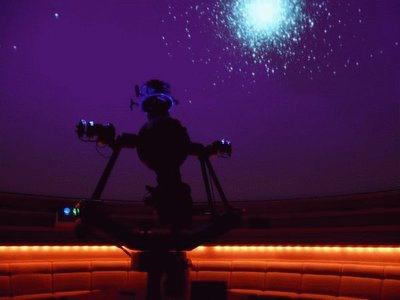November 6, 2008
Planetarium open to public for winter of starry, starry nights
Seattle winters all but guarantee buckets of rain, blustery winds and — unfortunately for stargazers — clouds, clouds, clouds.
The good news is that you can still “see” the stars this winter, even on the cloudiest nights. For the first time, the UW Astronomy Department Planetarium will be open for free shows every first and third Wednesday Nov. 19 through Feb. 25. Astronomy graduate students will present the original shows, which will start promptly at 7 p.m. and last about an hour.
Previously open only to school groups and other organizations on Fridays, the planetarium shows will allow stargazers to keep up with astronomy during the cloudy months — December through February — when the Jacobsen Observatory is closed. The planetarium is in the A-building (Auditorium building) of the Physics-Astronomy complex. The planetarium itself is on the second floor at the far end of the hall.
Each show will be different, according to astronomy graduate student Phil Rosenfield, who organized the program and will present the first show.
Rosenfield said his show will be about the planets, including the history of humans’ observations and interesting information about each planet. Future shows will focus on extragalactic astronomy and celestial navigation, and each show will include a bit about what is currently happening in the sky, he said. Click to see a schedule of the shows.
The planetarium features a dome that is 8 meters in diameter, a permanently mounted digital projection system, a “starball” projector and a library of digital visualizations. The starball projects all the stars and planets visible from Earth onto the dome, as well as the sun, moon, Milky Way and three nearest galaxies. Motors allow presenters to control the starball to show visitors how the sky looks and appears to change from any location on Earth.
Presenters also use three digital projectors and the special effects library to demonstrate complex concepts, like meteor showers and black holes, through animations, movies and digital images. For example, the moon show on Feb. 25 will include video clips from the Apollo missions, Rosenfield said.
Shows are open to everyone and will be geared toward a typical public audience. Rosenfield said the graduate student volunteers are experienced presenters and have taught astronomy to visitors of all ages.
“Anyone who can pick up a magazine or read an article in a newspaper about astronomy will easily understand the shows,” he explained. However, children under the age of 5 are generally discouraged, as the planetarium is very dark.
“I think this is a great opportunity to have a free introduction to our night sky and it’s a great time to learn about astronomy for fun,” Rosenfield said. “The idea is that we’d like to get more people involved and reach out to not only public student groups, but to anyone who is interested and curious about the night sky.”
Tickets to the planetarium shows are free, but must be reserved online at the planetarium Web site. Reservations can be made up to two weeks in advance of each show. There is a limit of four tickets per reservation per show.



